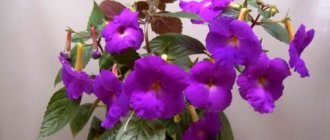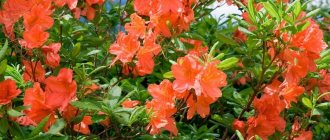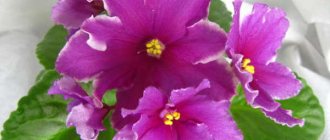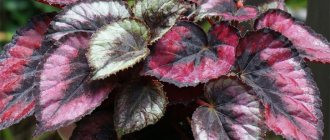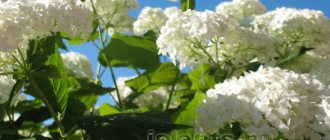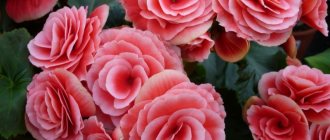Begonia: Description and origin
Begonia was first introduced to Santo Domingo in 1690 by botanist Charles Plumiero. It was described by C. Linnaeus and named the genus in honor of Governor Michel Begon. The plant belongs to the genus Begoniaceae.
The plant has an erect stem, lodging, herbaceous and succulent, on which the nodes are strongly pronounced. The number of internodes reaches 10-12 and corresponds to the number of leaves. The root system is well branched; some species produce tubers.
The inflorescence is a complex panicle with constantly growing lateral inflorescences. In the axil of each leaf of the main shoot, starting from the fifth or sixth, an inflorescence is formed, consisting of three to five male and female flowers.
Important!!!
The apical (terminal) flower is always male.
Begonia flowers are heterosexual, irregular in shape (zygomorphic), with a brightly colored perianth. The male flower consists of four round and elongated oval petals, two sepals and two membranous, slightly colored round-oval bracts. The female one has four to five petals, a calyx of three free sepals and two bracts.
Begonia
Tuberous begonia has large flowers (5-15 cm), while evergreen begonia has small flowers (2-3 cm). The lower ovary is three-locular, the pistil is equipped with three pairs of fused and helically twisted stigma blades, the surface of which is covered with thin needle-shaped papillae. The fruit is a three-lobed winged capsule, cracking along the side seams.
The seeds are very small, orange-yellow, with cells on the surface. Despite their small size, mature seeds have a differentiated straight embryo without endosperm.
On a note!!!
In ornamental gardening, evergreen begonia (B. semperflorens Link et Otto) and tuberous begonia (B. x tuberhybrida Voss) are usually used. Recently, seeds of more and more new varieties of begonias have been appearing in flower shops.
The quality and appearance of plants depend on proper agricultural technology and the nature of the soil. In favorable conditions, begonia grows well, blooms profusely and is practically not damaged by diseases and pests. Therefore, before growing it, you need to choose a place to plant it, create the right substrate and take care of proper watering.
Garden begonia in landscape design
As a rule, three varieties of begonia are used to decorate home gardens and gardens, which include many varieties.
Tuberous begonia
B. tubergybrida. It reaches a height of no more than 30 cm. It is endowed with large double and non-double flowers of a wide variety of colors. This species has dioecious flowers, so both female and male buds can appear on one plant.
It begins to bloom in early summer and continues until autumn. The circumference of flowers can vary from 6 cm and reach up to 21 cm. The flower can be of a variety of shapes, resembling a rose, carnation or lotus.
Drooping or drooping begonia
B. tubergybrida pendula. This is a separate type of ampelous form. It is characterized by long bushy stems, which are completely covered with inflorescences of different colors.
Terry ever-blooming begonia
B. semperflorens. Contains a fairly large number of varieties. Plant height is about 15 cm. They have small, smooth, oval-shaped leaves. The foliage color can be either brown or green. The flowers are collected in inflorescences in the form of a “cap” in white, red and pink.
How and when to plant in the garden
The most suitable time for growing begonias in the garden is the end of spring. To begin with, slowly dissolving phosphorus and potassium fertilizers need to be added to the holes prepared for planting the plants, after which they are thoroughly watered.
To make plants feel comfortable, they should be planted at a certain distance from each other.
- Thus, compact types of begonia should be placed in holes spaced 25 cm apart, while large ones will require approximately 35 cm.
- Ampelous varieties are planted in special containers with an interval of about 10-15 cm.
If transplantation is carried out, then the tubers should be placed in the hole a few centimeters deeper than they were located in the pot.
- Typically, begonias in a garden or flower bed are planted in multiple samples of the same color, which is shaded by completely opposite or other types of flowers.
- Another option is to plant flowers in one tone, often pastel shades of pink, cream and yellow.
- It is also very beautiful to mix contrasting colors, a classic example: red and snow-white inflorescences planted in rows.
No matter how you decide to plant begonia in the garden in open ground or in a pot, or keep it as a houseplant, one thing is certain - the pleasure of contemplating this flower will outweigh all possible difficulties in caring for it.
Begonia: temperature
The origin of begonia from tropical areas left an imprint on its heat-loving nature. It does not tolerate negative temperatures and is not winter-hardy. The need for heat manifests itself already at the first stage of its development. The optimal temperature for swelling and germination of seeds is 20-22° C. Young plants (seedlings) are especially sensitive to changes in heat.
Begonia Cleopatra
The most favorable air temperature for the plant is 16-18 ° C. Subsequent development of begonia proceeds better at a temperature of 22-24 ° C. Increasing the temperature to 25 ° C enhances the growth of the vegetative parts of the plant, regardless of the length of the day.
For the successful development of the horse system, a temperature of 18-20° C is needed. A decrease to 8-10° C leads to a slowdown in root growth. Causes withering of the crop and death of the flower. Temperatures above 25° C disrupt the vital processes of begonias.
Important!!!
If the bushes have already formed, then they are able to tolerate a drop in air temperature to 5-7 ° C, but even slight frosts can destroy the above-ground part of the begonia.
Tuberous begonias develop better at moderate temperatures and slightly increased air humidity. They are planted at a distance of 20-25 cm, deepening the tubers by 1.5-2 cm. They respond well to fertilizing during flowering.
Diseases and pests of begonias
Begonia is most often infected with such diseases.
Powdery mildew
The infection manifests itself in the form of characteristic white spots located on all above-ground parts of the plant. To combat the disease, the affected begonia and its neighbors on the windowsill are treated with an aqueous solution of a Topaz-type fungicide. To completely get rid of powdery mildew, re-treatment is carried out after a week and a half.
Gray rot
Affects leaves and stems of begonias. If the infected parts are not sprayed in a timely manner with a 1% solution of Bordeaux mixture or a 0.2% solution of Fundazol, the plant may die.
Ring spot
Signs of this disease include yellow-green spots and dead areas on infected leaves. This type of blight is often concentrated in the tubers of the plant, so it is best to get rid of the diseased begonia to protect other plants. The carriers of this virus are thrips and aphids, so they must be completely destroyed to prevent infection of other flowers.
Bacterial spot
At the initial stage, it appears on the underside of the leaves in the form of water bubbles, which gradually turn brown, covering the shoots and inflorescences. Diseased plants are removed, and healthy begonias are treated with a 0.5% copper chloride solution every 2 weeks as a preventive measure.
Soft false scale
When begonia is infected with this disease, dark sugary secretions and sooty fungi appear on its green mass. An infected plant very quickly loses its shape, and its leaves become noticeably deformed. Infected begonia is treated with tincture of garlic or pyrethrum at a dose of 10 g per liter of water every 14 days.
Greenhouse whitefly
The pest lays eggs on the underside of begonia leaves. Larvae and adults suck the sap from the plant, as a result of which the leaf blades begin to turn yellow. Laundry soap (40 g of soap per 10 liters of water) will help destroy whiteflies.
Root nematode
This is a microscopic worm that parasitizes the root of begonia. Growths and air voids form on the stem in which the larvae develop. The roots begin to rot, the plant stops growing and may die. Infected begonia roots are removed, and the plant is watered with a 0.05-0.2 percent heterophos solution. Prevention consists of disinfecting the soil with a 1% formaldehyde solution or steam treatment.
Spider mites and aphids
These pests can cause significant damage to begonias. Timely removal of fallen leaves and flowers will help prevent their occurrence. At the first alarm signals, it is necessary to wipe the leaf plates with a weak soap solution. If this does not help, you will have to resort to treating begonias with insecticides (you can use Neoron, Fitoverm, sulfur, Decis and others). An effective folk remedy is onion infusion: 15 g of onion is infused in 1 liter of water for 5-7 days. The resulting solution is sprayed on the plants every 5-7 days until the pests disappear.
Aphid
Spider mite
Begonia: lighting
In the first phases of development, it is better to grow begonia in diffused light, since direct sunlight burns the leaves and kills small plants. In the phase of three or four true leaves, begonia needs sufficient lighting. Budding and flowering occur better in open rather than shaded areas.
Begonia photo
Begonia is a short-day plant. An increase in night temperature during a short day accelerates the formation of flowers, and during a long day it slows it down.
In conditions of a 10-16 hour day at an air temperature of +15 ° C, active formation of flowers occurs. With a short day, under the influence of sunlight, the plants bloom faster, but the growth of shoots in tuberous begonia stops, and the tuber increases in size.
Reproduction
Cuttings
Propagation by cuttings is a quick and easy way to grow a new tiger beauty.
- Select a healthy, medium-sized seedling. Cut it with a disinfected blade and place it in moist soil.
- Place the pan in a warm, dark place (temperature +23 degrees).
- As soon as roots appear, transplant the plant into a pot.
Seeds
A less popular distribution option. Seeds can be bought at a specialized store, and of the two forms - regular and granular - it is better to choose the latter. Soft seeds are unprocessed; granulated seeds are sold in pellet form and are much easier to work with. But both of them plant the same:
- Soak the seeds in a weak solution of potassium permanganate (1%) for 30-45 minutes, then rinse under running water. This will kill pathogenic bacteria.
- Wash the seeds and plant them in a damp peat bed, then place the cushion on a tray under plastic or glass. The room temperature must be at least +20 degrees Celsius. Pour water into the tray from time to time to keep the tablet moist.
- The first shoots should appear in 2-3 weeks. After the third shoot appears, the plants in separate pots should be thinned out. The second transplant should take place approximately 8 weeks later.
Dividing the bush
Propagation from mother flowers is best done simultaneously with rejuvenation, since the root system still needs to be removed from the ground.
Cut off the part or section of root protruding from the ground, sprinkle the cut with ash (you can also use charcoal or ground activated carbon), let the grains dry for 30-40 minutes, and then plant them in pots with soil.
Cover the pots with plastic wrap (or clear glass) and set aside in a dark place.
Be sure to use drainage material, such as shredded polystyrene, for propagation.
Useful video
Begonia Tiger - propagation methods and mistakes when growing at home:
Begonia: watering
Wild begonia species grow in tropical areas with high air humidity, but they do not tolerate excessively damp soils.
Begonia watering
Similar requirements apply to growing begonia at home. Excess moisture is especially dangerous when growing seedlings, as young plants can die from root rot (blackleg).
Important!!
Begonia should not be watered with cold water at a temperature below 12° C. Because this causes the roots to die and the entire plant may die.
When grown in open ground, begonia needs abundant watering. If the summer is humid, with little temperature fluctuation and large amounts of precipitation, then there is no need for watering. It is very important that the plant receives the required amount of moisture during budding.
Important!!!
The optimal soil moisture for begonia is 80%, and air moisture 60-70%. Such conditions have a positive effect on the abundance and duration of flowering.
If the flowering time coincides with a hot and dry period of summer and the plant lacks moisture, then the buds and flowers will fall off, and the leaves will lose their decorative effect, so the begonia should be watered more abundantly.
On a note!!!
To maintain the required moisture, the soil is mulched with peat, humus or sawdust.
Mulching delays water evaporation, protects against weeds and enriches the soil with humus. To preserve tubers in winter, the soil must be almost dry, since waterlogging leads to rotting or premature germination of the buds.
Description of the appearance of begonia
The flower grows in the form of a bush, has large (larger than the palm of your hand) leaves of a rich green color with splashes - hence the name begonia. Young leaves are light green, but as they mature, the color darkens. The shape of the leaf is uneven, rounded and elongated, a bit like a heart. The reverse side is red. If you touch the sheet, it seems that it is wet or painted with oil paint.
This type of begonia blooms almost all year round. Large inflorescences hang in clusters (like grapes), and the flowers themselves are small - white or pale pink.
Begonia: GROWING conditions, planting
For planting, it is best to take young, undivided tubers, 5-6 cm in diameter. They are round and slightly depressed at the top. Old tubers are larger, flattened with stump-like outgrowths from old stems.
Begonia planting
Before planting, remove any remaining soil from them and carefully trim off the mass of dried roots. Young tubers are sometimes slightly wrinkled, but they are quite suitable for planting.
Important!!!
To disinfect and restore turgor, they are immersed for one hour in a solution of potassium permanganate (0.05%) at room temperature.
Growing usually begins in mid-March. They bloom in about 3 months. If there are a lot of tubers, it is advisable to plant them in boxes. The substrate is peat with the addition of chalk or fluff lime at the rate of 50-70 g per bucket of peat.
Planting of tubers occurs in the following sequence:
- the boxes are half filled with peat;
- lay out the tubers at a distance of 5-8 cm from each other;
- fill the gaps between them so that the tops protrude above the surface;
- The peat is slightly compacted and moistened with a solution of complete mineral fertilizer. (1-1.5 g per 1 l).
At first, when watering, water should not fall on the central part of the tuber.
Begonia planting
Boxes with tubers are kept in a bright place at a temperature of 18-22'C. On sunny days they provide shade by whitening the glass in greenhouses. During the growing period, 3-4 feedings are carried out. The first - 4-5 weeks after planting, the subsequent ones after 2-3.
It is advisable to alternate feeding with organic and mineral fertilizers. At the beginning of May, the boxes are taken out to warm greenhouses, shaded and provided with good ventilation. About three weeks before planting in the ground, the plants begin to harden off. Planting in the ground, balcony boxes and containers is carried out only after the end of spring frosts.
Growing spotted begonia
Begonias planted in early spring take root best. You need to choose a medium flowerpot that is spacious enough. The plant loves light soil, so use mixed soil:
- leaf soil;
- peat;
- turf;
- sand.
When planting begonias, be sure to place pieces of polystyrene foam or expanded clay at the bottom of the flowerpot to create a drainage layer.
Begonia: harvesting tubers
The first frosts serve as a signal to harvest the tubers for storage. The above-ground part is cut down to 2-3 cm with pruning shears, dug out with a shovel or garden fork without clearing the soil from the roots, the tubers are placed in boxes and transferred to a warm, ventilated room.
After about 2 weeks, remove the remaining shoots, which by this time are easily separated. The tubers are dried and stored in the basement at a temperature of -10°C and air humidity of 80-85%. The gaps between the tubers are covered with peat and, if necessary, a second layer of tubers is laid.
Caring for begonia at home
Lighting
The first priority when caring for begonias indoors is to choose a suitable location. Most representatives of this genus prefer bright, but diffused light. Only tuberous species like partial shade.
In poor lighting conditions, light-loving plants stretch out, the stems become thinner, and the pattern and color of the leaves fade. In the absence of natural light, the crop responds well to fluorescent lighting.
Temperature
The optimal daytime temperature in summer is +20-25 ̊C with high humidity, in winter - +18-20 ̊C. Cold drafts and prolonged exposure to low temperatures should be avoided - these factors can destroy a heat-loving plant.
Begonia tolerates winter well at a temperature of +16°C with moderate watering.
Landing
To plant begonia, you need to fill 1/3 of the volume of the pot with drainage material and put a 2-3 cm thick layer of charcoal on top, which will prevent the formation and spread of rot. Then you need to place the root ball in the pot and fill all the voids with soil mixture.
To successfully grow begonias, you need soil rich in nutrients. It should consist of:
- 2 parts leaf soil;
- 1 part peat;
- 1 part black soil.
After planting, the begonia is watered. The flower is planted in the spring, starting in mid-March, when the optimal length of daylight hours for plant development is established. Before planting, begonia should be germinated in boxes in a bright place at a temperature of +16-18°C, combined with high air humidity (60-70%).
Germinating begonias before planting
Watering
Regular watering is one of the prerequisites for caring for begonias at home. This indoor plant is moisture-loving, but this does not mean that it needs to be watered often. It is much more important to ensure a sufficient level of air humidity, otherwise the tips of the plant’s leaves will begin to dry out. Abundant watering is only appropriate on hot summer days. However, you need to make sure that the water does not stagnate at the roots.
Many experts recommend watering begonias when the top layer of soil becomes dry. This will help avoid overwatering, which is the main cause of plant death.
Try to water the flower in a circle, evenly distributing the water over the soil and avoiding it getting on the leaf blades, so as not to provoke the development of fungal diseases.
Begonia needs to be watered at the root.
Begonia should be watered with water at room temperature, left to sit for 24 hours. The right time for the next watering is when the soil has dried to a depth of 1.5 cm. In winter, the frequency of water procedures must be reduced, and tuberous varieties do not require watering at all at this time.
Top dressing
For the successful growth of begonias, fertilizing is very important, and nitrogen fertilizers that stimulate leaf growth are suitable for deciduous species, and phosphorus-containing fertilizers are suitable for flowering ones.
Transfer
Tuberous begonias are repotted into a new pot and soil every spring, while varieties with fibrous or branched rhizomes require repotting only when the pot becomes too crowded. The plant must be carefully removed from the old pot and its roots dipped in a solution of potassium permanganate (potassium permanganate) for disinfection. After removing the damaged areas, the begonia is transplanted into a larger pot with fresh soil.
Begonia transplant
Begonia: reproduction
Begonia propagation: Begonias are usually propagated by dividing tubers, cuttings and seeds.
Begonia: propagation by dividing young tubers
When dividing, young tubers are first germinated. For germination, they are laid out in a warm room on moistened peat. After the buds wake up, the tubers are cut into 2-4 parts, sprinkling the cuts with charcoal and sulfur powder.
Begonia propagation by rhizome division
Divisions with dried cuttings are grown in the same way as whole tubers, but they begin to do this 2-3 weeks earlier, since division somewhat inhibits the development of plants.
Begonia: propagation by cuttings
When propagated by cuttings, mother tubers begin to grow in January at a temperature of 20-22'C. After about a month, the cuttings are broken out by lightly pressing at the base. For summer flowering, it is enough to leave 2 sprouts on the tuber. Damaged areas are sprinkled with charcoal and sulfur powder.
Begonia leaf propagation
After light drying, the cuttings are planted in sandy-peaty soil to a depth of 2-3 cm; it is advisable to powder the sections with charcoal with the addition of growth stimulants. Boxes with cuttings are regularly moistened, shaded and kept at a temperature of 20″C.
Rooting usually occurs after 20-30 days, after which the cuttings are planted in boxes with a mixture of leaf humus, peat and sand (2:1:1 or 3:2:1) at a distance of 8 cm from each other and placed in a bright place. As they grow, young begonias are fed with organic fertilizers.
Begonia propagation by cuttings
On a note!!!
Young seedlings often do not have time to form tubers suitable for winter storage, and they are cultivated as annuals.
Valuable varieties are grown in pots, which are pinned into the ground for the summer. At the end of August, the plants are brought indoors and grown until November (the flowers are removed), then the stems are cut off, and the tubers in pots are placed in winter storage.
Begonia from seeds
The most effective method of propagation is seed. Sowing is done in late December - early January. Seedlings usually bloom by the time they are planted in the ground.
Begonia from seeds
The seeds are very small, up to 50,000 in 1 g, so they are sown without covering them in shallow bowls or boxes with a sifted mixture of:
- leaf soil;
- peat;
- sand.
Take 2 parts of leaf soil, and 1 part of tofa and sand. If the peat is acidic, then add fluff lime (50-100 g per bucket of mixture).
Ultra-small begonia seeds germinate well if snow is poured onto the substrate and the seeds are scattered over it. When it melts, it will slightly draw the seeds into the substrate, and you will have what you need.
For disinfection, the substrate is moistened with a solution of potassium permanganate (0.1%). The crops are kept under glass and before the first picking they are evenly moistened with heated water (about 30'C) from a tray. Shoots appear in 12-14 days. The glass is first raised, and after a few days it is removed completely.
They dive at the stage of 2-3 true leaves. A month later, a second pick is carried out. Two weeks after the second picking, they begin to feed with mullein once every 7-10 days with the addition of potassium nitrate (1 tablespoon per 10 liters of infusion). At the end of April - beginning of May, one specimen at a time is planted into 7-11 cm pots.
On a note!!!
Begonias at any age can tolerate transplantation without pain, but their very fragile leaves must be protected. In the future, care is the same as for plants grown from tubers.
Tuberous begonias are short-day plants. It is advisable to plant specimens that are lagging behind in development or obtained from late sowings in a separate bed and, from mid-July, completely shade them with opaque material for 3-4 weeks from about 6 to 9 p.m. This helps to increase the size of the tubers by about 1.5-2 times. It is recommended to do the same with cuttings.
On a note!!!
The ripening of tubers is also facilitated by the removal of flowers.
Begonias are used in flower beds, garden beds and as a potted plant. The popularity of these plants is explained by the abundant and colorful flowering throughout the frost-free period. They go well with many low annual flowering and decorative foliage plants.
Pruning and propagation of begonias
To stimulate the growth of side shoots and the formation of a beautiful bush, you need to cut off the top of the plant. Since begonia blooms on young shoots, it is rejuvenated every 3-4 years - maximum pruning is carried out.
If the fact of flowering is not so important, but you want to get large leaves, you can tear off the buds to redirect the force of the begonia to leaf growth.
The cuttings and leaves remaining after rejuvenating the begonia can be planted to produce new plants. Begonia also reproduces by dividing the bush.
Begonia: varieties, varieties, types
The genus contains over 1,600 species, growing in tropical and subtropical regions of America, Africa and Asia. Of these, about 400 hundred species are cultivated at home.
Begonia albo – picta Bull
Homeland - Brazil. Bush perennial plant. The stem is highly branched, up to 1.0 m high. The leaves are shiny, green, ovate-sharp, with small protrusions, densely covered with white dots. Flowers with white and pink petals grow in clusters.
Begonia albo – picta Bull
Due to its decorative properties, it is widespread. Shade-tolerant. In summer, diffused light and abundant watering are needed. Grows well in warm and cool rooms. Propagated by stem cuttings after 2 years. Young plants are more decorative; with age, the lower branches become bare. They are replanted annually in an earthen mixture, like other begonias.
Begonia Bismarckii Veitch
Homeland - Jamaica. An evergreen, unpretentious indoor plant. The stems are smooth, red, juicy. The leaves are large, pointed, fleshy, up to 20 cm long, bright green above, with small grayish dots, red below. Flowers in large clusters, bright red, luxurious.
Begonia Bismarck
Propagates well from stem cuttings. Loves a bright location. Bismarck begonia is replanted annually in the spring.
Begonia heracleifolia
Homeland - Mexico. Stem - thick, short, creeping rhizome. Perennial evergreen hairy plant. Leaves are up to 18 cm in diameter, with 5-9 deep, narrow, slotted and serrated lobes, dark green, petioles 40-50 cm long, straight, flowers are white with a pink tint, small, with 2 prominent rounded parts.
Begonia heracleifolia
This decorative species has many varieties: with leaves bordered along the edges with a dark green, almost black stripe (V. var. nigricans Hook.), or with hogweed-green leaves and silvery stripes along the nerves, purple below, etc. (V. her. var. sunderbruchii hort). Propagated by rhizomes and apical stem cuttings. In summer, a semi-shaded location is required.
Welton's begonia (Begonia weltoniensis)
This bushy, beautifully flowering begonia was obtained by hybridization. A plant of medium height with succulent branched stems, thickened at the base. The leaves are small, light green, double-coarsely toothed. The stems, leaf petioles and leaf veins are red. Blooms profusely from spring to late autumn with small bright pink flowers.
Welton's begonia (Begonia weltoniensis)
In winter, some of the shoots die off. In spring, young shoots develop from the base of thickened stems. The plant is shade-tolerant. Easily propagated by cuttings.
Welton's begonia has abundant and long-lasting flowering, and the red petioles and veins of the leaves, standing out against the background of lush light greenery, give the plant a special originality. High decorative qualities and unpretentiousness allow it to be widely used in many forms of landscaping.
Begonia semperflorens
Perennial evergreen plant. Forms low (20-40 cm), lushly branched bushes with succulent, fragile stems, which in older plants become woody at the base. The leaves are medium-sized, on short petioles, juicy, bright green, shiny, slightly obliquely heart-shaped, with small teeth along the edge, each of which ends in a soft point. There are varieties with beautiful pinkish, reddish or brown-brown leaves.
Begonia semperflorens
Evergreen begonia flowers, depending on the variety, can be white, pink or red. They are located several at a time in the leaf axil. When flowers are pollinated, fruit-boxes with small seeds are formed.
The plant got its name because of its abundant flowering, which lasts from spring to autumn. The flowering period can be extended if the plant is pruned short in the spring and kept in bright windows, and if it is watered and fed abundantly in the summer.
Easily propagated by cuttings and seeds. One of the most common begonias, during its cultivation numerous varieties have been bred. Unpretentiousness, ease of propagation, and high decorative qualities allow the use of evergreen begonia when creating any interiors. Widely used in outdoor landscaping, when decorating flower beds and balconies.
Hybrid tuberous begonia (Begonia x tuberhybrida)
Tuberous begonias are represented by a huge variety of varieties obtained through hybridization. Back in 1870, gardeners managed to obtain many hybrids. Thus, the breeder Vilmorin in 1891 obtained a winter-blooming begonia from two wild species. This is Gluard de Lorraine (named after the famous artist). Modern varieties produce flowers 20-30 cm in diameter (Everest variety). In size they exceed the flowers of large chrysanthemums and peonies.
Hybrid tuberous begonia
A common feature of these plants is the presence of a tuberous-thickened rhizome. From 1 to 5 low shoots with herbaceous, translucent stems develop from the buds of the rhizome. The leaves are alternate, obliquely heart-shaped, unequal, with a pointed apex, and in some varieties covered with thin, sparse hairs. In the axils of the leaves there are peduncles, each of which bears 2-5 flowers.
Flowers, depending on the variety, can be simple, double, semi-double, fringed, curly, narcissus-like. The color of the corolla comes in a wide variety of colors and shades: white, yellow, pink, red, orange. Blooms all summer until late autumn.
In summer, tuberous begonias are kept in well-lit places, watered and sprayed abundantly. In the fall, when the plants begin to go into a dormant state, watering is reduced. After the shoots dry, the tubers are left in the same pots and watering is stopped, but the earthen ball is not allowed to dry out completely, occasionally watering from the saucer.
Tubers overwinter well in indoor conditions, especially when kept cool.
Tubers are planted, depending on the planned flowering period, from February to May in soil composed of turf, humus and leaf soil with an admixture of sand. The tubers are placed in the soil so that the upper part rises slightly above the surface of the earth. Tubers germinate slowly, so watering during this period should be very moderate. Propagated by seeds, cuttings and tubers.
Abundantly and brightly blooming tuberous begonias are a picturesque decoration of any interior. They are also widely used in outdoor landscaping for the design of flower beds, ridges, tapeworms, etc.
Begonia Elatior
The species was formed by crossing tuberous and Socotrans begonias. The difference between the hybrid is its lush and long flowering. A photo of Elatior begonia can be seen below.
Indoor begonia Elatior is demanding to care for. She needs a well-lit place. Since it blooms poorly in the shade, and the flowers become small and not very attractive.
Begonia Elatior
The temperature in the room must be stable, and the presence of drafts is unacceptable. The most optimal option is 20-25 degrees. At low readings, the plant stops blooming. Humidity is high. You cannot spray the flower from above. To increase humidity, use trays of water or devices to humidify the atmosphere.
Begonia has a weak root system, so the soil must be loose. Drainage is necessary at the bottom of the pot so that water does not stagnate at the roots. This will help prevent them from rotting.
Watering is moderate. Excess water can cause rotting of the horses and death of the plant. The water should first be left at room temperature. During the flowering period, it is recommended to water more often, but only after the soil has dried from the previous watering.
Begonia Camelia
This is a tuberous large-flowered begonia. It is a powerful plant with thick stems and large double flowers. Its height reaches 30-35 cm. It blooms all summer and autumn.
Begonia Camellia
It has a dormant period - gradually stop watering in the fall, cut off the plants for the winter, and store the tubers in a cool place until spring planting. Do not remove indoor begonia tubers from the pot.
She prefers fertile soils with a slightly acidic reaction, light or slightly shaded rooms, the temperature in which should not exceed 23°C.
It responds well to feeding with mineral and organic fertilizers. Watering is moderate.
Periodically, the air around the plants should be sprayed, but make sure that drops of water do not fall on the leaves.
Can be grown in the garden in flowerpots or at home in a pot.
Royal Begonia (Begonia Rex)
It has large, luxuriously colored leaves that are simply impossible not to notice; in addition, this plant perfectly purifies the air due to its special properties.
Royal Begonia (Begonia Rex)
Royal begonia belongs to the begoniaceae family. Almost all of its varieties have very original asymmetrical leaves with an unusual color. In nature, begonias are most often found in tropical forests and mountains. However, they survive well at home.
Indoor royal begonia has a fairly large root system, which often rises above the soil. The leaves of this plant are wide, have a heart-shaped base and pointed edges. Depending on the variety, royal begonia has different leaf colors - from gray-copper to cherry-brown with a special shine.
The flowering of the royal begonia is quite modest and even meager compared to the leaves. It is the leaves that are the main advantage of begonia.
Share your experience in growing begonias by leaving a comment on the page.
Is it true that Spotted Begonia blooms all year round?
The plant received the name “begonia” in honor of Michel Begon, who was well versed in flowers and was a big fan of them.
In total there are about 2000 species of begonias. All of them are distinguished by fleshy leaves and long beautiful flowering.
Grows in tropical climates: Africa, Brazil, America.
The species Begonia Spotted or Begonia maculata Raddi belongs to the Begoniaceae family. This is a flowering shrub, belongs to the type of decorative deciduous begonias.
…
Characteristics and description
Begonia spotted is a fairly tall spreading bush. The leaves are smooth and shiny, dark green in color with white or gray specks on top, have an uneven shape: oblong, round, heart-shaped with an oblique center. The underside of the leaves is reddish in color.
The flowers are white and light pink, with a beautiful unusual shape. They are located on a drooping peduncle hanging down and are collected in small inflorescences.
Home care
Landing
They are planted in the spring, at the beginning of March, as the best growth occurs during this period.
Priming
The soil is mixed from different parts of peat, sand, turf, and leaf soil. The substrate should be loose and light.
Styrofoam or pumice is placed at the bottom of the pot to absorb excess moisture.
Choosing a pot
The pot should be spacious and medium in size.
Watering
In summer, you need to water the plant often and abundantly, but avoid overwatering. In winter, watering should be done moderately and the soil should not be allowed to dry out.
She loves soft, humid indoor air. But you should not spray the leaves and flowers to avoid darkening or rotting of the leaves.
Light mode
Spotted prefers bright light. Direct sunlight should be avoided, the light should be diffused. If there is not enough natural light in the room, then you can turn on fluorescent lamps.
You cannot suddenly move a pot with a plant from the sunny side to the shade or back.
To make the bush lush and beautiful, the top of the plant must be pinched. In order for the leaves to be large, the buds can be torn off. Old plants are rejuvenated by pruning every 3 or 4 years.
Dead leaves and flowers are removed in a timely manner to prevent rotting of the roots.
Thermal mode
The optimal indoor air temperature corresponds to the range from 20 to 25 degrees Celsius in summer and not lower than 16 degrees Celsius in winter.
Wind and draft should be avoided, and the pot with the plant should not be taken outside.
The plant is grown indoors or in a greenhouse; it is not suitable for planting outside. Also, the roots should not be allowed to overcool, so they need to be insulated. Polystyrene foam and synthetic winterizer are good for insulation.
Reproduction
They propagate using leaf and stem cuttings, as well as by dividing the bush. Leaf cuttings are dug into moist soil, then transplanted into a pot. Stem cuttings are placed in water, which is periodically replaced with fresh water until roots appear.
Fertilizer
Fertilize with a special fertilizer for ornamental flowering plants, which is applied 1-2 times a month from the beginning of March to the end of October.
Transfer
Replant every year, less than once every two years.
Features of winter care
There is no rest period in winter. It is watered moderately. In the spring they are transplanted into a new substrate.
Pests and diseases
Begonia can be affected by gray rot. Often occurs in high humidity and low light indoors.
Often fungal mold and powdery mildew may appear on the leaves.
Common pests: spider mites and aphids.
Control methods and treatment
Pest-affected or diseased leaves are removed, and the pruned areas are treated with a fungicide.
A solution of colloidal sulfur, which is sprayed on the plant, helps against powdery mildew. With the help of insecticides they fight against aphids and spider mites.
Begonia is an unpretentious plant to care for. It can bloom all year round under optimal conditions. At home, the plant restores a calm atmosphere, and is also used for medicinal purposes to treat headaches, conjunctivitis, and stomach ulcers.
Photo
Next you can see the photo:
Useful video
Begonia care video:
See inaccuracies, incomplete or incorrect information? Do you know how to make an article better?
Would you like to suggest photos on the topic for publication?
Please help us make the site better! Leave a message and your contacts in the comments - we will contact you and together we will make the publication better!
selo.guru

